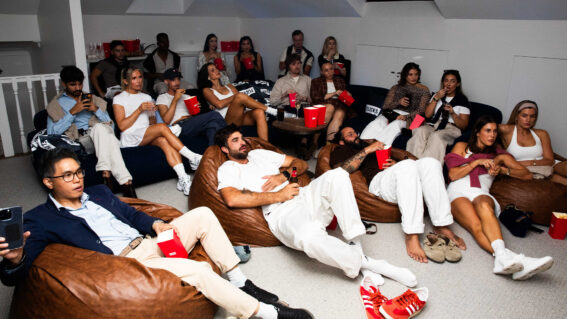Interview: Scarlett Johansson, Ari Arad, and Guy Norris on set of ‘Ghost in the Shell’
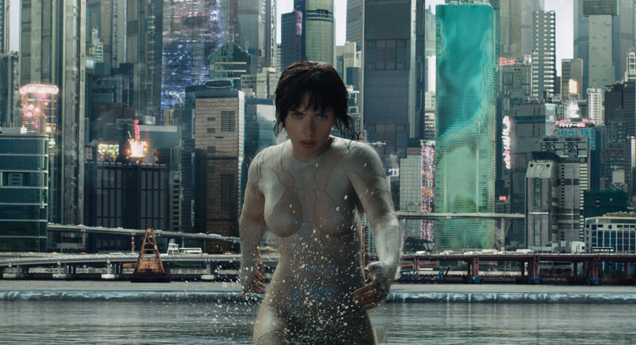
Wellington can be a pretty bleak place. Maybe you can’t beat it on a good day, but sometimes one can see exactly how the city can transform humans into Parliamentarians, or musicians into Fly My Pretties.
OK, maybe that’s a little bit much. But waiting for us on the set of the big budget, live-action, Ghost in the Shell adaptation that was shooting there earlier this year, we found a sight even more desolate than the Cake Tin concourse after a sporting capitulation. Although to be fair to Wellington, as we found out in a precious chunk of the interview time allotted to international press and a few locals like Flicks, Ghost in the Shell lead Scarlett Johansson did say of our capital city “it’s nice”. At least that was the sentiment expressed in response to a parochial enquiry from another outlet, one likely hoping to satisfy Kiwis’ (or at least editors’) need for validation from afar.
But back to the set. Amid the drizzle, doom and gloom, a futuristic Eastern street had been built against a green screen backdrop and subjected to extreme punishment – riddled with bullet impacts, debris, and explosive damage. Presumably Johansson (or her cohorts from Ghost in the Shell’s Section 9), had been trading gunfire – and probably more – in the open air of Miramar, though when Flicks asked how she’d spent most of her day, it was in a more claustrophobic environment.
“We’ve been shooting some stuff in the Kuze lair,” Johansson explained. “My character is doing a tactical entrance through an underground lair and all kinds of craziness is going on down there. She’s making her way towards the target to which she’s been attracted to – she’s been hunting, but has also felt this calling towards. And yeah, that’s what we’re doing out there.” You can get a sense of this sequence in the brand new trailer:
Like most of what we can reasonably expect from Ghost in the Shell, the lair itself drew heavily on the look of the source material as we made our way through it. And just as the manga took inspiration from elsewhere, moving around within it conjured thoughts of Blade Runner and other sci-fi predecessors – gloomy, tactile, mixing futuristic and low tech. In a word – cables. There were lots and lots of cables.
As producer Ari Arad (also on the upcoming Uncharted and Metal Gear Solid pics) explains, “So much of modern technology design is about hiding it from you as a consumer, which is frequently great, but in a movie, if everything’s wireless and tracks your retina and touch, that character’s going to just sort of be standing there waving their hands around, twitching their eyes. The cabling evokes something. You automatically know, it’s data use. It’s the great thing, in 1989, everyone’s connected but there’s some guy using, like, cyborg hands for a keyboard. That was as anachronistic then as it is now, but it was way more impactful.”
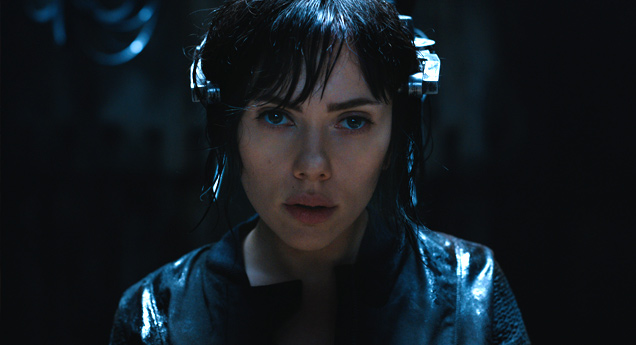
Concept art littered around the production office offered further pointers to the film’s aesthetic, much of it sketched out early on, prior to WETA Workshop’s heavy involvement in the look of the pic. Director Rupert Sanders (Snow White and the Huntsman), Arad recalls “came in with this, like, 100-page presentation featuring, images from all the different pieces of source material. That was the big one, we wanted something that felt really different and that also felt connected to the anime, and he’s such an artist. That’s the big thing, there’s just so many other visions of the future that we knew we didn’t want to fall into that trap, and Rupert was the guy to solve that.”
That’s right, the film’s drawing from all over the Ghost in the Shell franchise, a decision that Arad sees as an advantage. “That’s the nice thing with something that’s been running for this long, there’s so much material that you can sort of take the approach of original story, but hopefully, authentic characters and world. For us, a lot of it was wanting to sort of spend a little bit more time wrestling with some of these big ideas of, like, self, and memory, and identity, and also making sure we can sort of initiate a live action movie-going sort of audience into it.”
In that regard, the casting of Johansson certainly will not hurt in terms of reaching either sci-fi or action fans as well as a broader audience. While her recent-ish filmography may suggest otherwise to the casual observer, she doesn’t describe herself as a particular fan of the sci-fi genre. “I guess I like some sci-fi movies,” she tells us, “But I think it’s a trend that reflects the time that we’re living in. These films that question our identity, how our relationship will be as we advance in this digital age and how it affects our own identity as a race of people.”
“It’s funny because Juliette Binoche,” who Johansson mentions she is working alongside, “kept saying, “This sci-fi…” because she has all this techie jargon and stuff and was just blown away by this sci-fi world, saying “I’ve never done this genre of film before.” And I was like, “Welcome.”
“I can’t tell you the last time I had to say something that didn’t involve – I don’t know – bogeys converging on the oracle pavilion or something like that” Johansson says with a laugh. “So it’s a vocabulary I am more familiar with, I guess. I think it’s a result of the trend of films and maybe perhaps the weird transient state I’ve been in the past few years.”
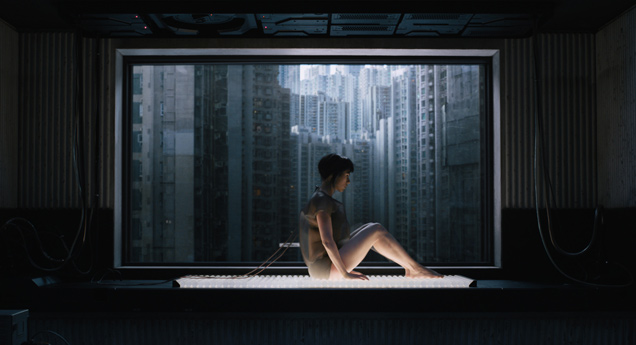
Part of that trend for Johansson is an increasing amount of action work, and the same is true – if not more so – here. “The film has a lot of action in it and I’ve really taken on the responsibility of doing a lot of the stunt work on this job” she explains. It’s not unfamiliar territory, but when pressed on whether it’s still scary, the answer’s part yes, part no. “I think there’s an element of fear when you do anything that’s really challenging, physically”, Johansson says, “but that’s part of what makes the action interesting to watch and it drives you to really nail it. I think that’s true in any kind of a performance, there’s got to be a certain level of, “Holy shit.”
Stunt coordinator legend Guy Norris (Mad Max: Fury Road) was strongly impressed by the actor’s physical work. “Well, she’s really done everything. We haven’t put her on the motorcycle at all – for insurance reasons, mostly” he laughs. “As you know, the Major is a ghost in the shell, and the shell is a high level robotic machine, so a lot of her fight work has been where we’ve tried to take her to a different level. So it’s not like a normal person fighting like– it’s so unlike her Black Widow character, for example, where she’s really a human who has good skills. We’re talking about someone who can do everything we’d probably like to be able to do – run faster, jump higher. She can’t fly – there’s no super powers there, but she can just do things in a different way. In a lot of her fight sequences, she has a couple of very special manoeuvres which she has done in each of the sequences, and so that involves a lot of wire work, and she’s really done them all herself. So her wire work has been exceptional.”
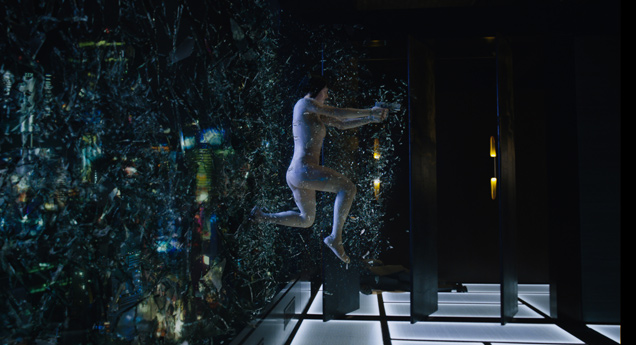
While the action sequences are what will no doubt impress Johansson’s physicality upon the average moviegoer, the actor sees this mode of expression throughout her own performance. “She’s really efficient and her physicality is always driving towards something,” Johansson elaborates. “She’s very driven and her movements are exact and precise, and I think removing the human qualities of her physicality have been challenging. Feeling emotion but not being able to show it in the same way has been challenging – and still express fear and isolation and loneliness and depression in a way. Just these feelings that we wear outwardly but she doesn’t, I guess, has been a difficult balance. Of course, she humanizes I think, as the film goes on and tracking that arc has been kind of challenging. But it’s good. I like it. It’s a risk.”
As Norris describes it, the action sequences themselves come with their own risk – in terms of a challenge, rather than harming the cast. “Our big push on this film was to do sequences in very long takes, so that we weren’t in a situation where it would be cut up” he notes. “And that’s just a filmic style, a lot of films are all very fast paced, and they all do it in cuts, whereas I much prefer to do it just in a long flow of physical action until it really breaks down itself. So you’re following a story as much as you can in the physical action, and appreciate what they’re doing. You want to be able to see a flow of how the physical moves, and Scarlett is a beautiful presence herself, to see her move and her flow in the fights is very important.”
So, Flicks asks, how does Norris know when he’s nailed a fight sequence? “Good question” he replies. “First of all, it has to be true to the story. That’s the most important thing. What can happen is that you’ll see a fight scene and it’ll be the same style of fight scene in several films, but the tone of the film will be entirely different. So that’s a mistake. It has to be true to the backbone and the story of the film. So, for me, physical action, or any action, is just unwritten dialogue. It has to move the character along. It has to be true to the work, and so it has to be real to the story. So it’s really basing it on the story. It’s like the fight scenes that we’ve done here. They’re different to the fight scenes we just finished in Suicide Squad, which is my previous film, and they’re different again to what we did on Fury Road, because the tone of the films are all different, so you have to be true to it. It’s like the dialogue in a film.”
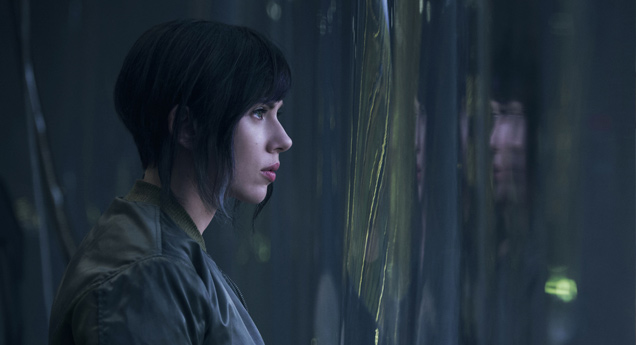
With an attentive inbuilt audience for Ghost in the Shell, the film’s details and its broader tone will be heavily scrutinised for accuracy to the source material. Much of what we saw suggests that deviations aren’t going to hugely bother moviegoers, and Arad has an interesting take on adaptations. “I think when movies are judged in terms of their fidelity,” he says, referring to how they bring their source material to life, “when people say if it’s faithful or not, sometimes they’re really just saying whether or not [they liked it].”
So, are we going to, Ari? “Here’s the thing, the movie’s going to come out and either they’re going to feel like, “Wow, I felt like I loved this in one format, and I feel really inspired by how it became a live action version,” or they’re not going to like it, and the casting will be a piece of that, but it’s not going to be the only piece. We’re all fans of it, and felt right to us. That’s the thing, the Internet frequently is sort of a one-way thing right now. I’m not a big social media guy, so– I don’t know, we’ll see. We really just hope to win them over because they like the movie.”
‘Ghost in the Shell’ opens March 30th 2017















